Melissa Groo, a nature photographer and story teller, visits places “on the edge of wildness, sits quietly and observes.”
She was rewarded on this day, capturing the “spirit and essence” of this bobcat. You can follow this sequence of events, and get a glimpse into the biology and behavior of this wild cat, a master of survival. Here is Melissa’s story:
Bobcat Image #1 of 7
This is a story that relies on a series of 7 photos. Once I drove down into northern Pennsylvania as I’d heard short-eared owls had been seen there. I was driving around in a remote rural area that seemed to have been taken over by fracking interests, with heavy trucks rumbling about. No sign of owls but as I looked out across a quiet hillside into the sun, I saw a largish housecat resting. I saw another picking its way through shadowed snow. And I suddenly realized these were no housecats; they were bobcats. With stubby tails and tufted ears.
Photo Gallery
Click to see larger imagesIn amazement I turned my car off and sat and quietly watched, my long lens resting on the windowsill. The resting bobcat got up and began to move and I realized with shock that he was missing half his front left leg. My mind began to race, wondering how I might be able to assist this bobcat, find a local rehabber, etc. Suddenly, he assumed a hunting position, his body crouched and tense, his gaze fixed intently on something I couldn’t see. I quickly raised my shutter speed hoping I could get a sharp shot of him leaping. And leap he did, in the most dramatic arc I’ve ever seen an animal make. And he got his vole. He quickly scarfed it down, stood up and walked away. It was obvious this was no recent injury. He had learned to adapt to it, and make a life for himself despite his handicap. I was in awe of his spirit. I’ll never forget it. I will never know, but I feel pretty sure his injury is from a steel jaw leghold trap, legal in most states. The animals are skinned, their pelts sold. It means an excruciating, slow death for those trapped in these devices. Some animals chew their leg off to escape. I think it’s time to ban these traps; they are barbaric and cause tremendous suffering. If you agree, find out who in your state is working on this issue and lend your voice. Follow orgs like @wyominguntrapped that fight for humane treatment of our wild neighbors. Note: I am not anti-hunting. I believe ethical, sustainable hunting for food is more humane than factory farming. What I am against is human cruelty, and animal suffering. Everyone has their passions. These are mine.
- From 1863, by Charles Darwin,on the cruelty of the steel-jaw leghold trap,
“It is scarcely possible to exaggerate the suffering thus endured from fear, from acute pain, maddened by thirst, and by vain attempts to escape. Bull baiting and cock fighting have rightly been put down by law….Some who reflect upon this subject for the first time will wonder how such cruelty can have been permitted to continue in these days of civilization; and no doubt if men of education saw with their own eyes what takes place under their sanction, the system would have been put an end to long ago. We shall be told that setting steel traps is the only way to preserve game, but we cannot believe that Englishmen when their attention is once drawn to the case, will let even this motive weigh against so fearful an amount of cruelty.”
Bobcat Image #2 of 7
“Like most wild felines, bobcats are not capable of extended chases, so they must get close to their prey, without being seen, before launching their attack. Their spotted coats provide excellent camouflage against vegetation or the ground. Such camouflage is especially effective in the dappled light of the forest. For small cats such as the bobcat, and for the young of all species, camouflage also protects against larger predators. Variations in the bobcat’s pelage occur throughout its range. Northwestern populations seem to have more colorful coats and more distinctive spots than eastern or southern bobcats.” “Bobcat: Master of Survival” by Kevin Hansen
*Bobcat trapping season in Wyoming is November 15-March 1. There are no quotas. Any trapper can take an unlimited number of bobcats.
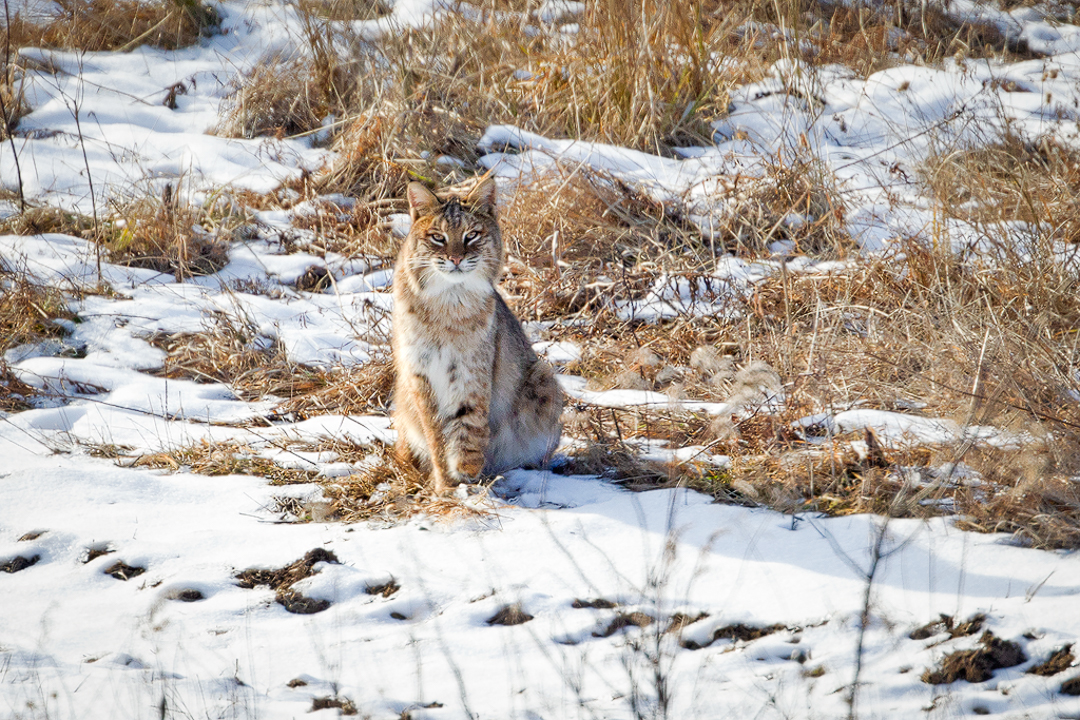

Bobcat Image #3 of 7
“Bobcats are stalking and ambush predators. Like most cats, with the notable exception of cheetahs, they attempt to catch their prey unaware rather than chase it down. They are master hunters that employ patience, speed, and precision rather than brute force. The cat is silent on approach, quick on the attack, and efficient in making the kill. “Bobcat: Master of Survival” by Kevin Hansen
*Steel leg-hold and padded-jaw traps baited with a scent attractive to bobcats or other predators are used. Animals are usually killed with a blow to the head or shot. Steel leg-hold traps are banned on public lands in some states.
*Bobcat paws, when caught in leg-hold traps, can freeze if wind chill dips to -10F or below. ”Typical foot hold traps and snares often produce some level of complete or partial restriction of blood flow to the limb distal to the mechanism and/or damage at some level to the tissues at the gripping point. Adding extreme hypothermic conditions would presumably make the situation worse.” Winston Vickers, DVM, MPVM, Associate Veterinarian, Wildlife Health Center, UC Davis
It is highly likely that a leg-hold trap or snare was the cause of the loss of the bobcat’s foot.
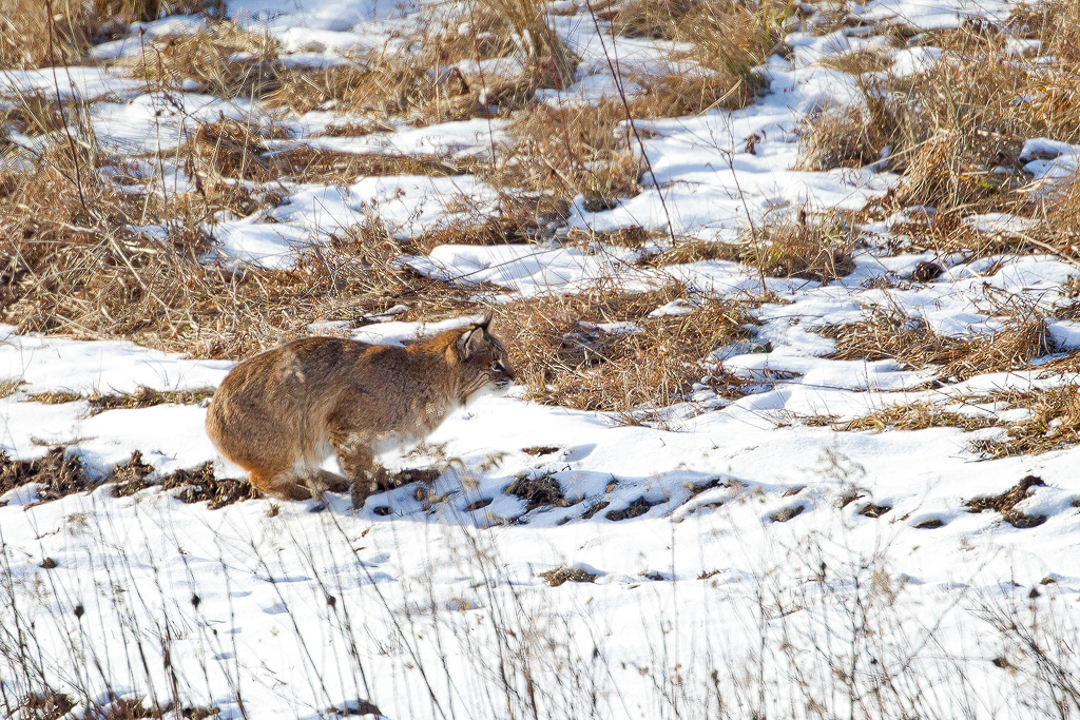
Our bobcat reported harvest has been:
- 2007=3036
- 2008=2978
- 2009=1609
- 2010=1606
- 2011=1875
- 2012=1872
- 2013=1571
- 2014=1140
- 2015=1164
- 2016=1397
“Sharp claws are important for seizing and controlling prey so that the killing bite can be delivered. To keep their claws sharp, bobcats have spring-like ligaments that keep the claws retracted inside fleshy sheaths and elevated above the ground most of the time. Retraction of the claws is passive, requiring no conscious effort on the part of the cat. In use, the muscles in the forelegs contract, which in turn protracts the claws, and the bobcat is ready for action .” “Bobcat: Master of Survival” by Kevin Hansen.
*Bobcat trappers are required to present their pelts for mandatory tagging in accordance with the Convention on International Trade in Endangered Species (CITES). Although bobcats should be protected under international laws such as CITES, loopholes, exemptions and lax enforcement have allowed a huge international market for trading bobcat fur.
*Wyoming bobcats are commercialized. The 2017/2018 harvest numbers are not being released to the public until late June, 2018 by the Wyoming Game and Fish Department.
Bobcat Image #5 of 7
“When bobcats are foraging for mice or voles in long grass, an extended stalking approach is not possible. Here the wild cat employs a brief stalk followed by a high, curved jump, similar to what a fox uses to catch a mouse. Such an approach allows the bobcat to pounce directly on its prey, trapping the animal against the ground with its forepaws.” “Bobcat: Master of Survival” by Kevin Hansen
*Persons possessing a valid furbearer trapping license may use dogs to take bobcats during the bobcat hunting or trapping season.
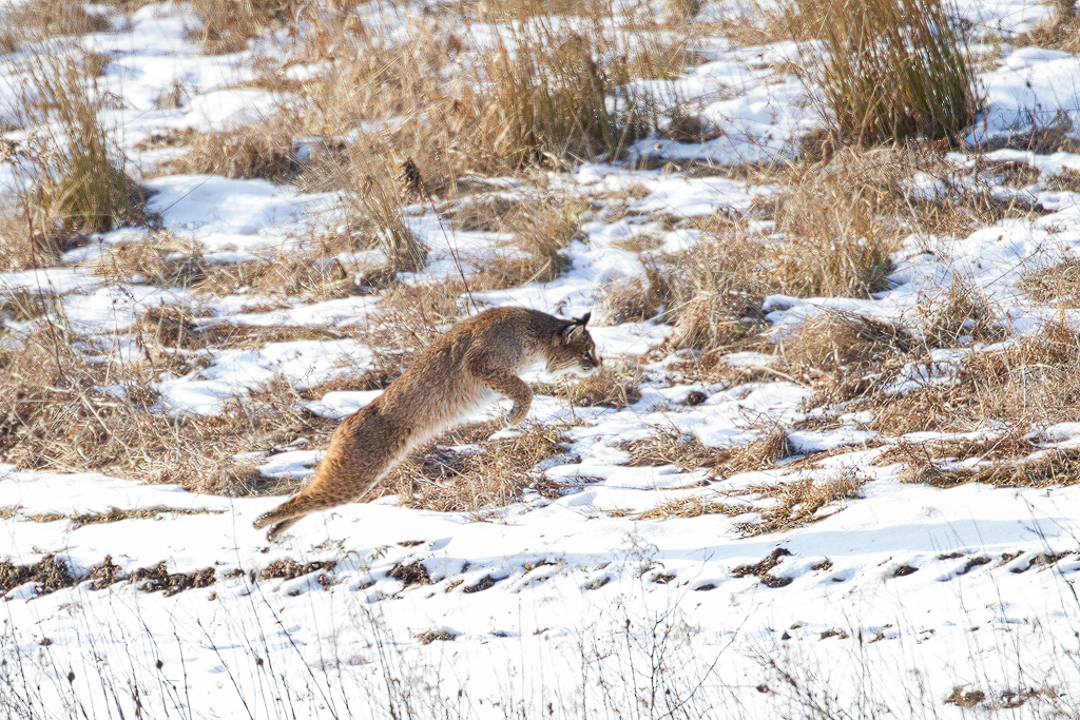

Bobcat Image #6 of 7
“Once the rodent, hare, or rabbit is seized and pinned with the bobcat’s forepaws and claws, it is usually killed with a bite to the nape of the neck or head. The nape bite is faster if the feline’s teeth can penetrate the prey’s skull or sever the spinal cord.”
*How many bobcats are out there? “Wildlife managers have long used total annual harvest estimates of an animal as a reflection of its population levels. Although this may be valid for many game species, some biologists think it may not work for bobcats, or for other furbearers, for a variety of reasons. First, annual harvest estimates will reflect changes in population levels only if harvest pressure is relatively constant. Second, furbearer harvest levels are often directly related to pelt prices. Third, some furbearer harvest declines may occur only after repeated overharvests. And fourth, harvests may also be influenced by factors such as weather conditions during the fur harvest season.” “Bobcat: Master of Survival” by Kevin Hansen
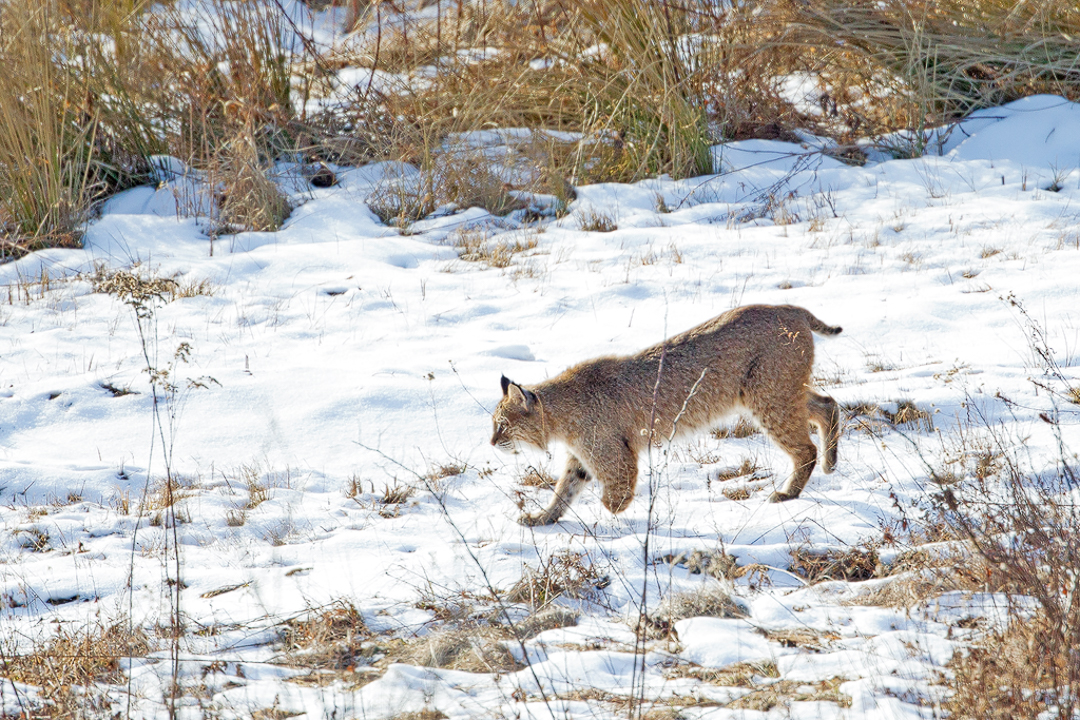
Bobcat Image #7 of 7
“If a bobcat is stalking or walking on snow or on a muddy surface, its track sequences shows a direct register of tracks. This means that the rear feet are placed almost directly in the corresponding impression of the front feet. If it is walking normally, an overstepped register or slight offset direct register occurs. The rear feet are placed on top of or forward of the front feet impressions. The normal walking gait has a stride length ranging from 28 to 58.4 cm (11 to 23 inches) and a trail width from 7.6 to 13.6 cm (3 to 5 3/8 inches).” “Bobcat: Master of Survival” by Kevin Hansen
*This bobcat has survived to adapt to its own unique track. May it continue to live wild, free, and untrapped.
We believe that bobcats should be preserved and protected for their ecological and intrinsic character on our landscapes, not hunted and killed in unlimited quotas.
© Melissa Groo Photography/All Rights Reserved 2014




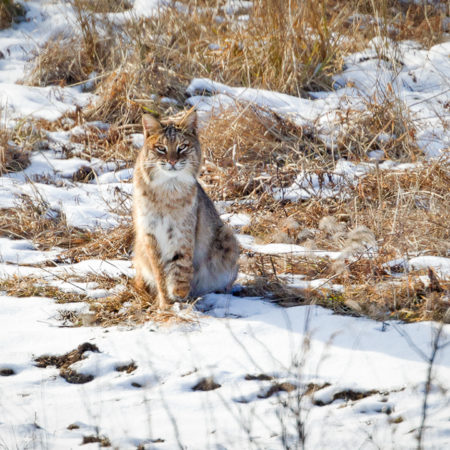


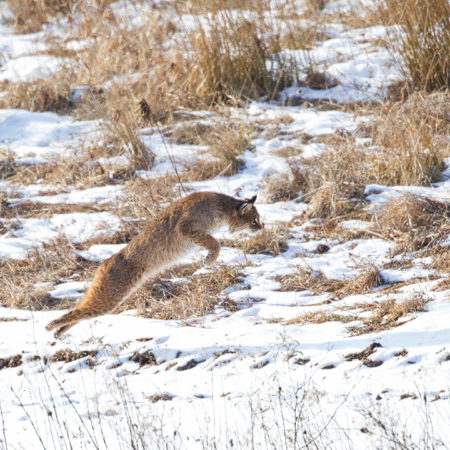
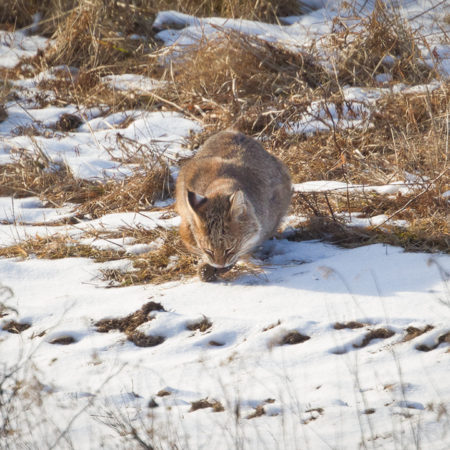

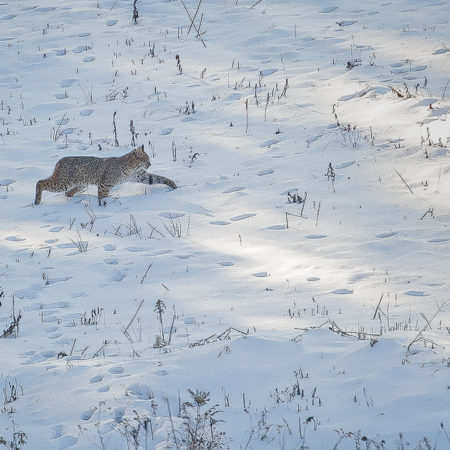
Bruce S. Thompson
Trapping is wrong.
As in: incorrect, mistaken, unsound, inappropriate, unsuitable, erroneous, inept, undesirable, amis, awry, faulty, flawed, defective, illicit, dishonorable, corrupt, unethical, immoral, bad, wicked, sinful, nefarious, reprehensible.
Just in case there is any confusion.
Marion Kiefer
Traps are heartlessly cruel. Stop them being used.
Emily Harris
This is wrong, sad and cruel. Hunting with traps and dogs is Not hunting.
Shame on Wyoming. I will never travel to or through that state!
Maria Matone
Is there a petition we can sign?
Larry G Brindle
First thing thru my computer…steel trap. Sad sight.
Maureen Mc cardell
Stop the cruelty.
Carla Cichocki
This is wrong
Carol Hoadley
Pass a bill that outlaw these cruel traps.
Carol Hoadley
Pass a bill that outlaws these cruel traps.
June ONeill
So wrong. If they really want to kill these animals they need to sit and wait. Trapping is so inhuman.
Jackie Johns
I agree. Trapping is wrong.
Wild Red Fox, Adaptability Is Its Essence - Wyoming Untrapped
[…] @MelissaGroo, a nature photographer and conservationist, reported that while she photographed a bobcat hunting a vole, it also proved to be a remarkable three-legged master of […]
Come Back to Silence – Trapping Reform in Wyoming
[…] @MelissaGroo, a nature photographer and conservationist, reported that while she photographed a bobcat hunting a vole, it also proved to be a remarkable three-legged master of […]